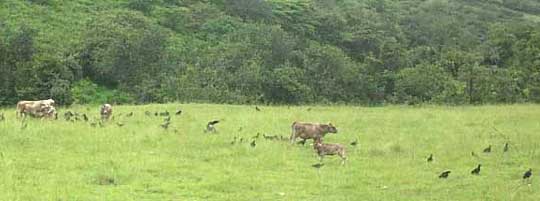Excerpts from Jim Conrad's
Naturalist Newsletter
from the September 7, 2007 Newsletter issued from Sierra Gorda Biosphere Reserve, QUERÉTARO, MÉXICO
60 BLACK VULTURES JUMPING
On another rainy day this week I walked past a pasture in which over 60 Black Vultures were scattered in the grass among grazing cattle, as you can see below:

What the photo doesn't show is that every second or so a vulture would jump into the air, seem to spread its wings as if trying to frighten something in the grass before it, and then land in that grass, look into it and sometimes peck there. I was too far away to see exactly what was happening.
However, I've observed egrets and herons wading in shallow water and a Cooper's Hawk on dry land flashing their wings, apparently trying to scare prey from before them. It looked like the vultures were doing that, though I can't be sure. If I had to guess, I'd say that the vultures were feeding on small, juvenile toads, of which multitudes appeared on the rain-soaked road that day.
It wouldn't be too surprising for this to be case, for Black Vultures are known to take living prey. A page at http://www.sheepusa.org warns sheep farmers that Black Vultures "subdue, capture and eat live prey, including birds, skunks and opossums, turtle hatchlings and fish," plus there are stories about them killing livestock.
In fact, Black Vultures have a bit of a thuggish reputation. Black Vultures can't locate decaying carcasses by smell the way Turkey Vultures do. Often Turkey Vultures locate a carcass by its odor, descend to eat, and when Black vultures see the landing Turkeys they land en masse, drive away the less aggressive Turkey Vultures, and eat their fill.